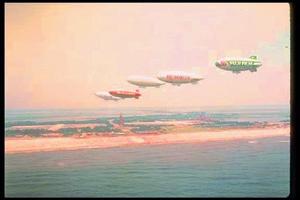BlimpsAround-the-world blimp race scheduled for 2011
A Texan businessman is organizing a year-long around-the-world race for airships — he says he is on track to start the inaugural event next year; the race is intended to be run as seventeen back-to-back legs that would see the competing ships set off from the zero meridian in London before progressing around the world in an easterly direction

The Great Blimp Race // Source: airshipman.com
A Texan businessman bidding to organize a year-long around-the-world race for airships says he is on track to start the inaugural event next year.
Among those lending their names to the project is Norm Augustine, who headed President Obama’s panel examining the U.S. manned space program last year
Lewis Page writes that the global airship race plan has been dubbed the World Sky Race, and is intended to be run as seventeen back-to-back legs that would see the competing ships set off from the zero meridian in London before progressing around the world in an easterly direction.
The event is the brainchild of airship enthusiast Don Hartsell, a former engineering entrepreneur in Houston, who says he has committed $2 million of his own money to the project and raised another $2 million from unnamed sponsors. Augustine, who was CEO of Lockheed before serving as chairman of Obama’s NASA panel, is on board as an advisor. He describes Hartsell as a “free spirit” in a Wall Street Journal report on the race the other day.
According to Hartsell, the initial race would be a historic event as it would see the “first full circumnavigation by a lighter-than-air skyship.”
Page notes that some would say that this is not true, as the legendary interwar dirigible Graf Zeppelin flew round the world in 1929. Hartsell, however, would no doubt point out that the zeppelin stayed well north of the Equator during its famous journey and covered less than 22,000 miles as a result. A great-circle circumnavigation — for instance around the Equator — would cover nearly 25,000 miles, and the planned Sky Race route will see the competing ships travel 30,000+ miles.
Apart from Augustine and his unnamed donors, Hartsell has secured the backing of the UNESCO World Heritage Centre, as the plan is for the racing airships to pass various designated world heritage sites and so focus attention on them: the UN officials hope that this will mean the sites get better care taken of them as a result. French electropop phenom Jean-Michel Jarre — a UNESCO Goodwill Ambassador — will also be lending his talents as the race’s “artistic director”.
Hartsell hopes to accumulate a prize purse of €10 million from commercial sponsors. He has already signed up Eurosport as broadcast partner, and other supporting organizations include Nokia, National Geographic, and Greenwich borough council in London — the race is supposed to start and finish on the zero meridian line at the Observatory there.
Regarding the class details of the actual ships to be raced, the Sky Race Web site specifies 200-footer blimps along the same general lines as the Goodyear advertising fleet. The ships are to be helium-filled in line with modern practice: hydrogen ships like the Graf Zeppelin have been out of favor since the Hindenburg went down burning in 1937, putting an end to the era of the pre-Second World War rigids.
Page writes that Goodyear blimps cruise at about 35 mph, or 50 mph flat out. They can carry fuel for twenty-four hours, though an eight-hour day is more normal on a cross-country flight. The ships generally spend the night moored to a mast on a support vehicle which follows by road. A Goodyear blimp would struggle to manage more than 1,000 miles in a single flight, and it needs specialist support facilities wherever it lands. A company spokesman told the WSJ that the race would face “significant operational challenges.” One major issue will be the need to avoid headwinds or other adverse weather.
